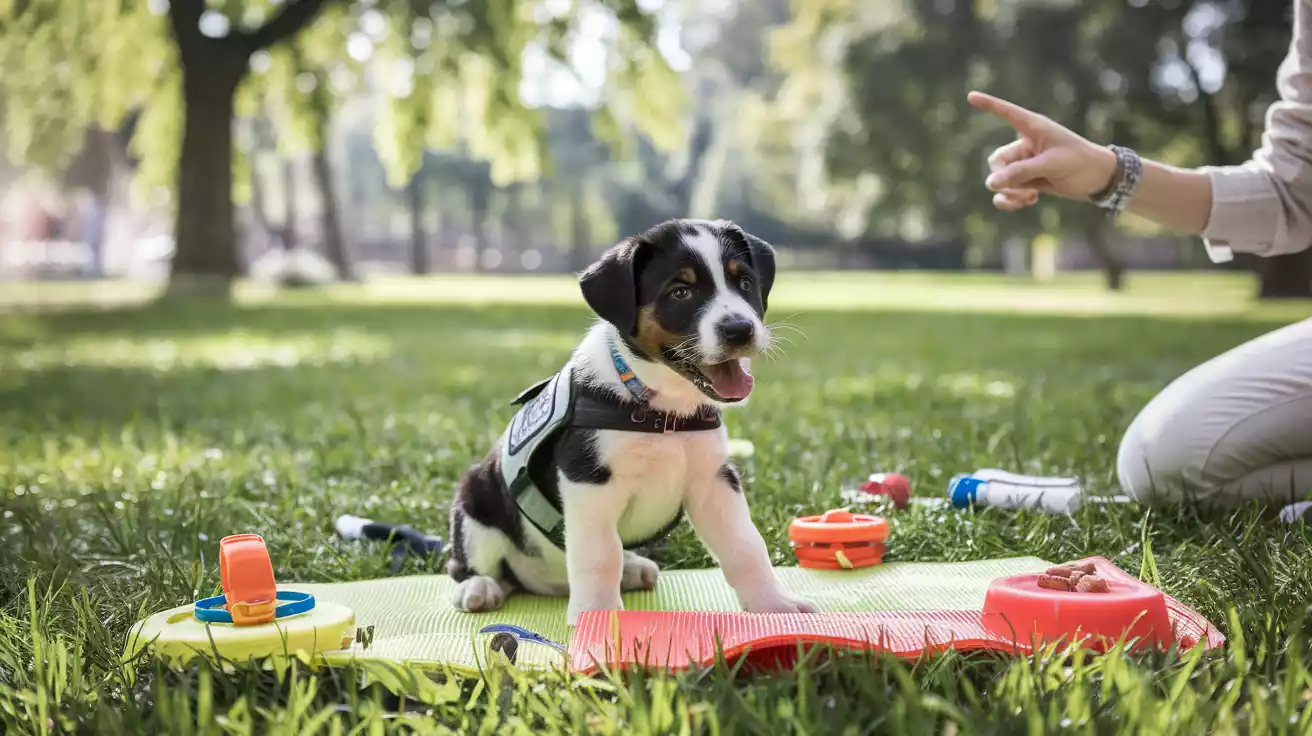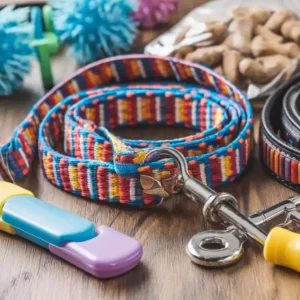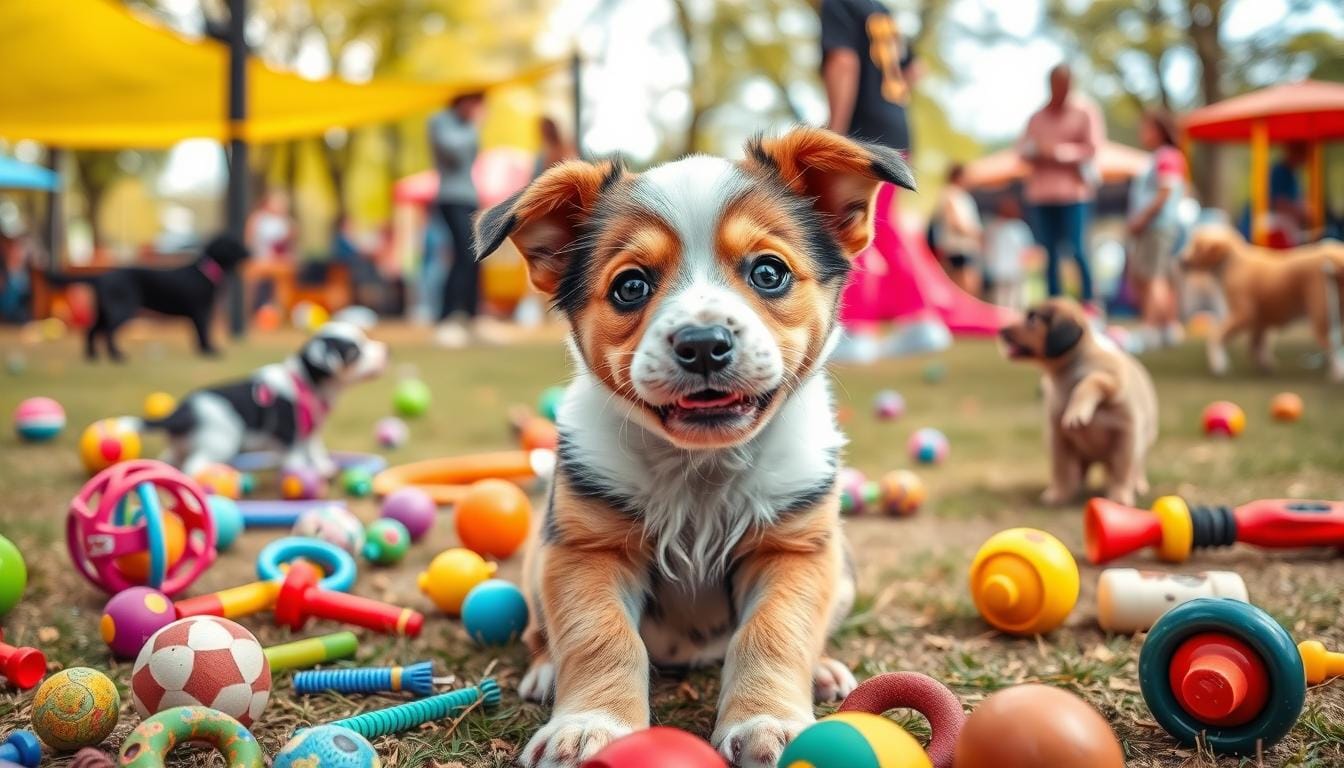
As a dog owner, you might have felt frustrated when trying to train your puppy. They often seem to ignore you. This is because up to 60% of training issues come from distractions around them1. Knowing why puppies don’t listen is key to solving these problems.
Consistent training is vital. It helps 90% of puppies learn to listen with patience and persistence1. By using consistent methods, you can start teaching your puppy to listen.
Key Takeaways
- Up to 60% of behavior issues in training are attributed to distractions in the surroundings1.
- Consistent training methods increase success rates in dog obedience2.
- Ensuring consistent training over time leads to 90% of puppies learning to listen effectively1.
- Dogs can have short attention spans, affecting their ability to retain training commands2.
- Timely reinforcement is critical, and delayed rewards result in confusion about the desired behavior2.
- Understanding why puppies don’t listen is crucial to developing effective dog training tips and addressing puppy behaviour problems.
Understanding Why Puppies Don’t Listen: The Science Behind Puppy Behavior
Understanding puppy behavior is key when they don’t listen. Obedience training is important, but so is talking to your puppy. Research shows puppies might not listen because they don’t get the commands or are distracted3. This means we need to communicate well and interact with them early on.
Puppies have natural instincts and learn at different ages. Like kids, they go through stages that affect their behavior3. Knowing these stages helps us tailor our training to fix behavior issues and improve obedience.
Talking to your puppy right is crucial for solving behavior problems. Use positive methods and avoid punishment to build trust and obedience4. Every puppy is different, so be patient and consistent. With the right approach, you can overcome issues and build a strong bond with your puppy.
The Critical Role of Early Development in Puppy Obedience
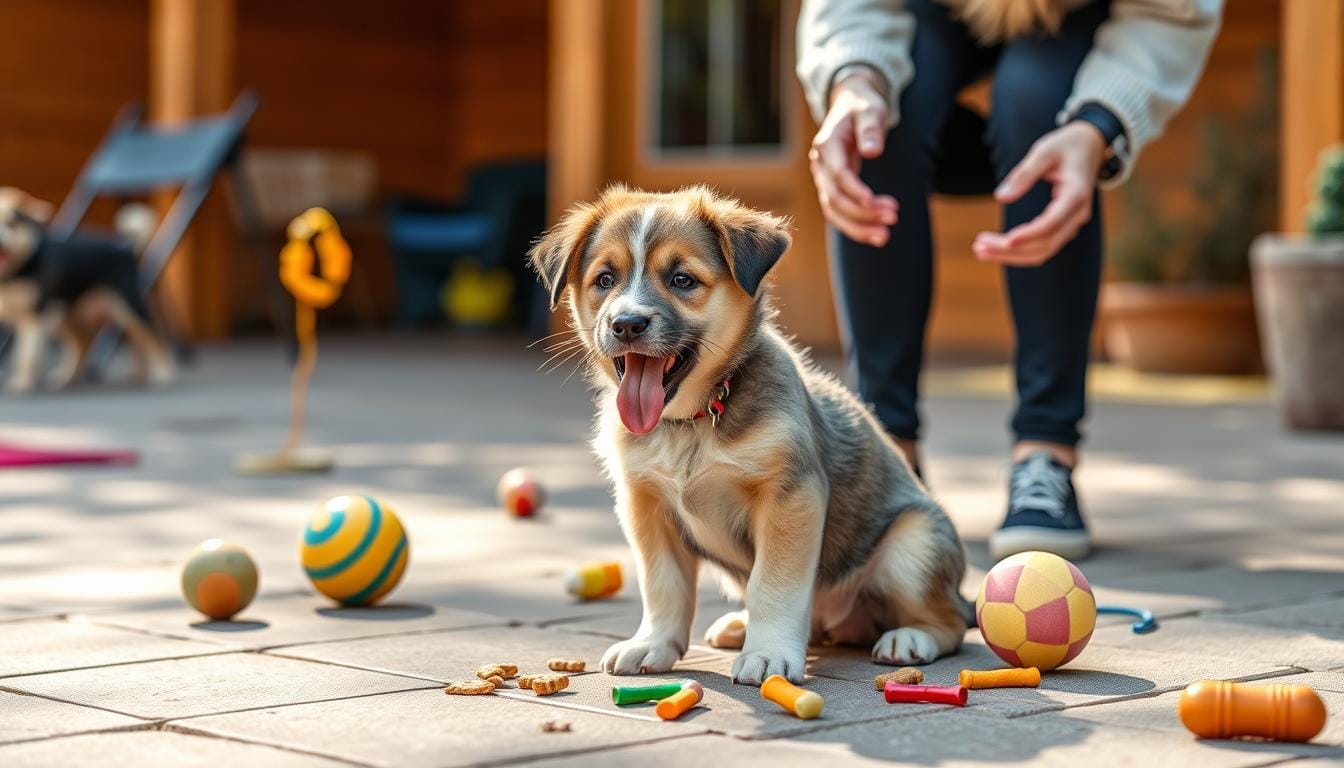
Early development is key in puppy obedience. Positive reinforcement training helps build a strong bond with your puppy5. It rewards good behavior and avoids punishment. This method creates a lifelong connection between you and your puppy.
Using puppy training techniques like clicker training and rewards, your puppy learns good habits early. This sets them up for a lifetime of good behavior and a strong bond with you.
Research shows that puppies that get regular eye contact during training do better. They respond up to 60% faster to commands5. This shows how important eye contact and positive training are. It helps your puppy feel more secure and increases their good behavior by 50%5.
Early development and positive training bring many benefits. These include:
- Improved obedience and communication
- Stronger bond between you and your puppy
- Increased desired behaviors and reduced undesired ones
Investing time in your puppy’s early development is crucial. It sets them up for a lifetime of good behavior and a strong bond6. Always use positive reinforcement training. Focus on building a strong bond through eye contact and rewards7.
| Puppy Development Stage | Age Range | Key Characteristics |
|---|---|---|
| Neonatal Period | Birth to 2 Weeks | Puppies are born blind and deaf, relying on their mother |
| Transitional Period | 2 to 4 Weeks | Puppies begin to see and hear, stand, walk, and recognize their surroundings |
Common Misconceptions About Puppy Training
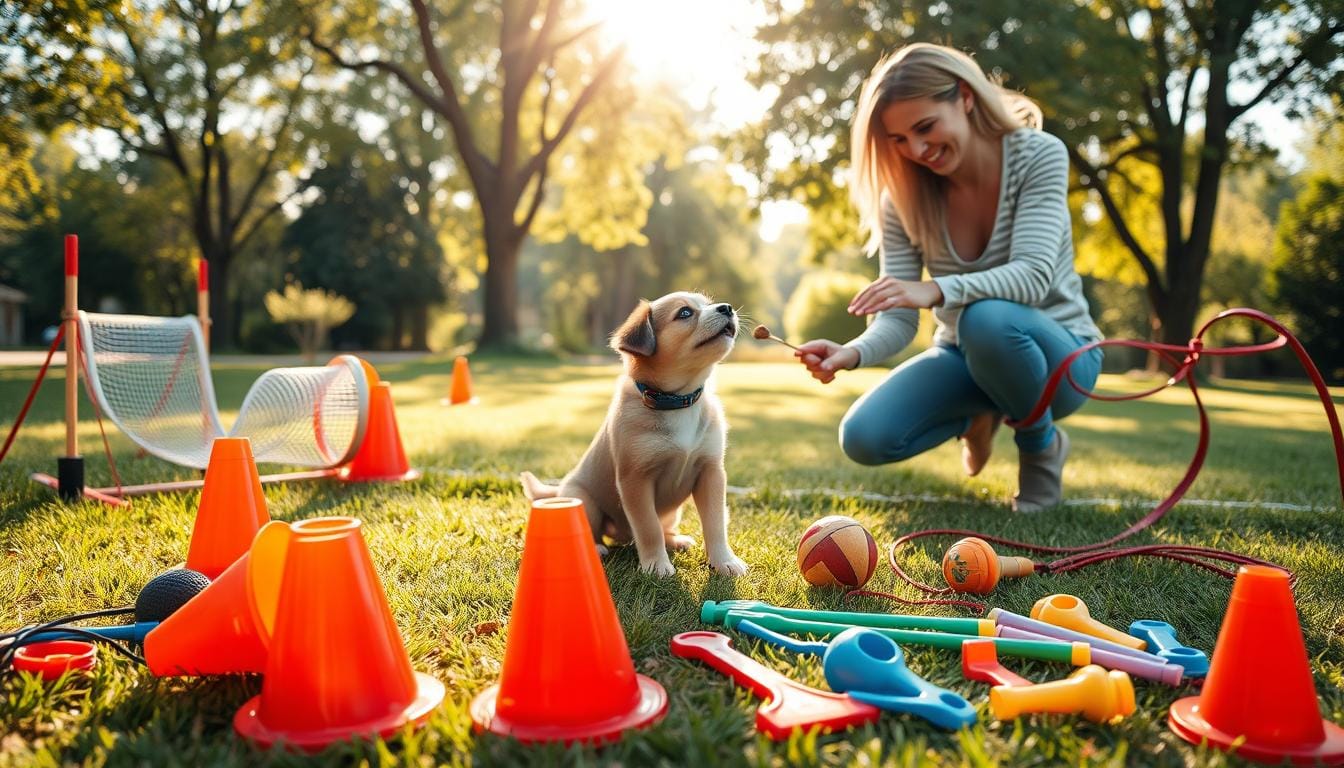
Many owners face challenges when training a disobedient puppy. They often rely on wrong methods and misconceptions. It’s key to know the common mistakes in training to communicate well with your puppy. Research shows about 60% of puppy owners don’t get how dogs learn, which hurts their training efforts8.
More than 70% of owners get frustrated when their dogs don’t listen in emergencies9. This shows how important it is to use the right training methods. Some think puppies are stubborn or only listen for treats. But, puppies really do well with positive rewards and consistent training.
Here are some key points to consider when training your puppy:
- Positive reinforcement techniques are essential for effective training, with approximately 85% of dog trainers advocating for this approach8.
- Consistent training is crucial, as inconsistent methods can lead to confusion and ineffective training.
- Understanding your puppy’s attention span limitations is vital, as puppies have short attention spans and require frequent breaks.
To train a disobedient puppy well, you need patience, consistency, and positive rewards. It’s important to know how to train a disobedient puppy and communicate effectively with them9.
| Training Method | Effectiveness |
|---|---|
| Positive Reinforcement | Highly Effective |
| Negative Reinforcement | Less Effective |
Building a Strong Foundation for Communication

It’s key to talk well with your puppy to solve behavior issues and train them well. Dogs have evolved with humans for thousands of years, making them great at talking to us10. This skill is vital for a strong bond with your puppy.
To get this bond, training must be consistent. This reduces stress and helps dogs understand what’s expected11. Having a routine also helps dogs learn better, making them less anxious when guests come over11. These tips help lay a solid base for talking well with your puppy.
Some important tips for a strong bond with your puppy include: * Making eye contact during training to improve communication10 * Using positive methods to teach good behavior11 * Tailoring training to how each puppy learns best11 * Watching your puppy’s body language to see if they’re stressed12 Following these tips and being patient and consistent will help you build a strong bond with your puppy. This bond will make training easier and strengthen your relationship.
Creating a strong bond with your puppy takes time and effort. But it’s crucial for solving behavior problems and training them well. By understanding your puppy’s needs and adjusting your training, you can build a lifelong bond of trust and respect101112.
| Tip | Description |
|---|---|
| Establish eye contact | Enhances communication and builds trust |
| Use positive reinforcement | Encourages desired behaviors and reduces stress |
| Monitor body language | Recognizes signs of stress or overwhelm |
The Impact of Environment on Puppy Learning
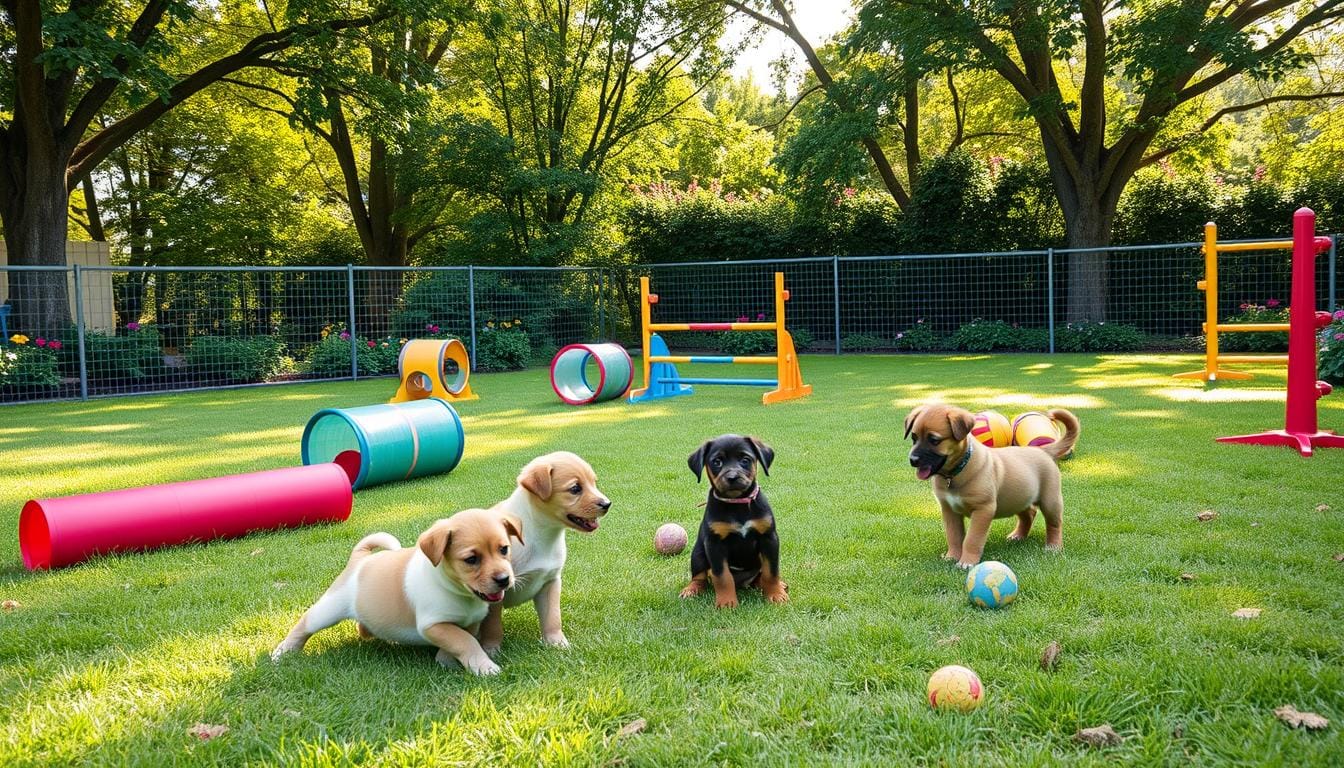
Understanding how environment affects puppy learning is key. The place where your puppy learns shapes their behavior. It’s important to manage distractions for effective training13. An ideal learning space helps your puppy focus and learn better.
Positive reinforcement training is a great tool. It encourages good behavior and stops bad behavior14. Using high-value rewards and keeping distractions low helps your puppy learn good habits. Research shows puppies socialized well are less likely to have problems later15.
Creating a great learning environment involves: * Keeping distractions away, like other pets or people * Using positive reinforcement training * Making sure the space is comfortable and safe * Always watching your puppy to prevent bad behavior14
By following these tips and setting up a good learning space, your puppy can grow into a well-behaved adult dog. Always use positive reinforcement and be patient and consistent in your training13.
| Training Technique | Description |
|---|---|
| Positive Reinforcement | Encourages good behavior with rewards |
| Redirection | Redirects undesired behavior to desired behavior |
Essential Training Techniques for Better Listening Skills
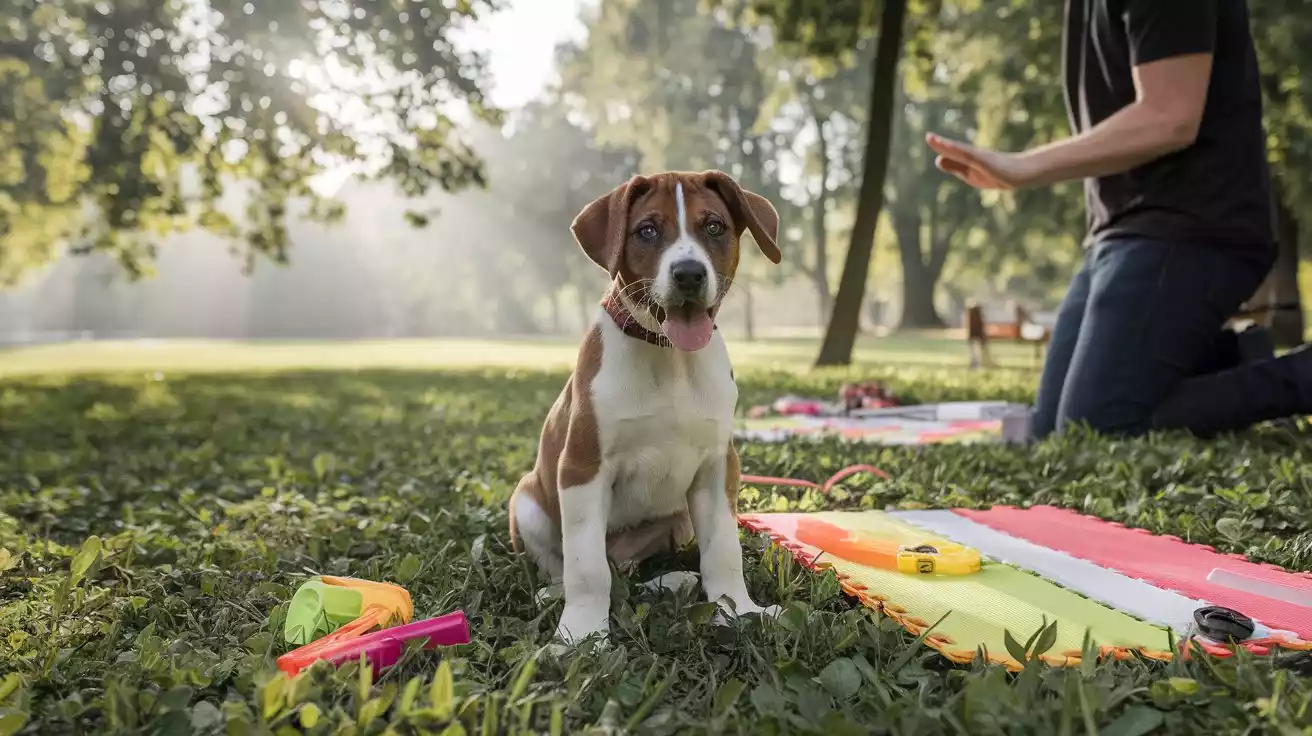
Training a disobedient puppy needs consistency and positive rewards. Research shows that dogs learn best when they get a treat every time they do something right16. This shows how important it is to use rewards to teach good behavior. Positive reinforcement helps your puppy listen better and strengthens your bond.
Good puppy training techniques mean setting clear rules and rewarding them often. For example, to teach your puppy to sit, use a treat to guide them and praise them when they get it right. As they learn, you can stop using treats and just praise them17. This builds trust and makes your puppy more likely to listen without treats.
Here are some key training methods to help your puppy listen better:
- Use positive reinforcement like treats and praise for good behavior
- Be consistent and clear in your training
- Stop using treats and use praise and affection as rewards
- Practice in different places and situations to help them learn everywhere
By using these methods and being patient and consistent, you can improve your puppy’s listening skills. Always focus on positive reinforcement and clear communication. This will help you raise a well-behaved and obedient puppy16.
| Training Technique | Effectiveness |
|---|---|
| Positive Reinforcement | Highly effective for encouraging good behavior17 |
| Consistency | Essential for setting clear expectations and improving listening skills16 |
The Power of Positive Reinforcement in Puppy Training
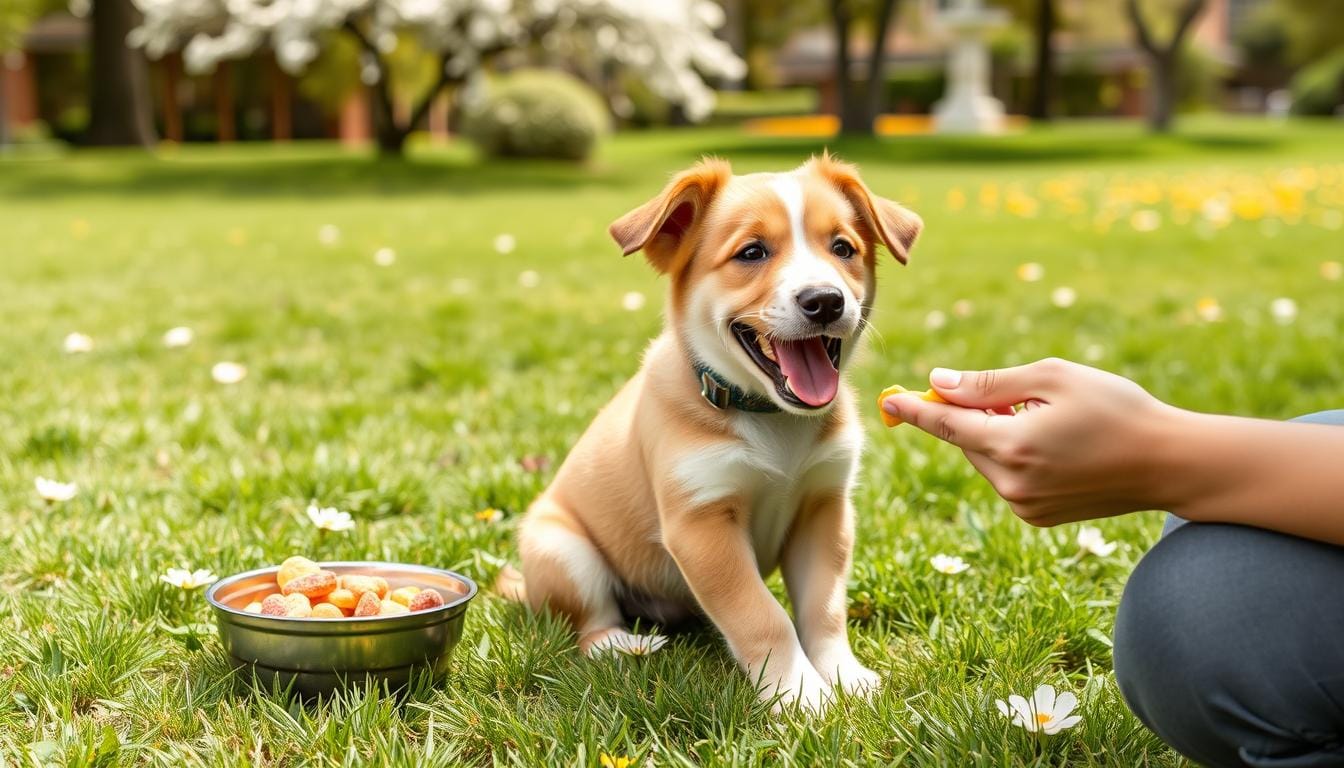
Positive reinforcement training is a great way to bond with your puppy and train them well. Studies show it’s very effective in teaching puppies new things18. It makes learning fun and rewarding for both you and your puppy.
Choosing the right rewards is key in positive reinforcement training. You can use treats, praise, and affection. It’s also important to be consistent and patient. This helps your puppy understand what’s good and what’s not19.
Building Positive Associations
Creating positive associations is a big part of positive reinforcement training. It links a behavior to a reward, so your puppy learns to do the behavior for the reward. For example, if you want your puppy to sit, give them a treat and praise when they do it right18.
- Be consistent and patient
- Use high-value rewards
- Keep training sessions short and fun
- Focus on building positive associations
By following these tips and using positive reinforcement, you can raise a well-behaved and well-trained dog19.
Addressing Common Behavioral Challenges
When you’re teaching obedience training for puppies, you might face some tough puppy behavior problems. It’s key to talk well with your puppy to solve these issues. Studies show that about 70% of dog owners struggle with their dogs chewing things they shouldn’t20. Other big problems include barking, digging, and licking too much.
To solve these problems, knowing why they happen and using positive training is important. It’s vital to be consistent with commands. If you’re not, your dog might not listen as well21. Also, not enough exercise and mental play can make dogs less responsive by 25%21. By fixing these issues and using good training, you can help your puppy learn good habits.
- Barking: Teach your puppy the “quiet” command with positive training.
- Destructive chewing: Give your puppy enough to do and teach them what’s okay to chew.
- Digging: Guide your puppy to dig in a sandbox and reward them for good behavior.
By working with your puppy and using the right training, you can tackle common issues. This will help you build a strong, loving bond with your pet22.
Creating a Consistent Training Schedule
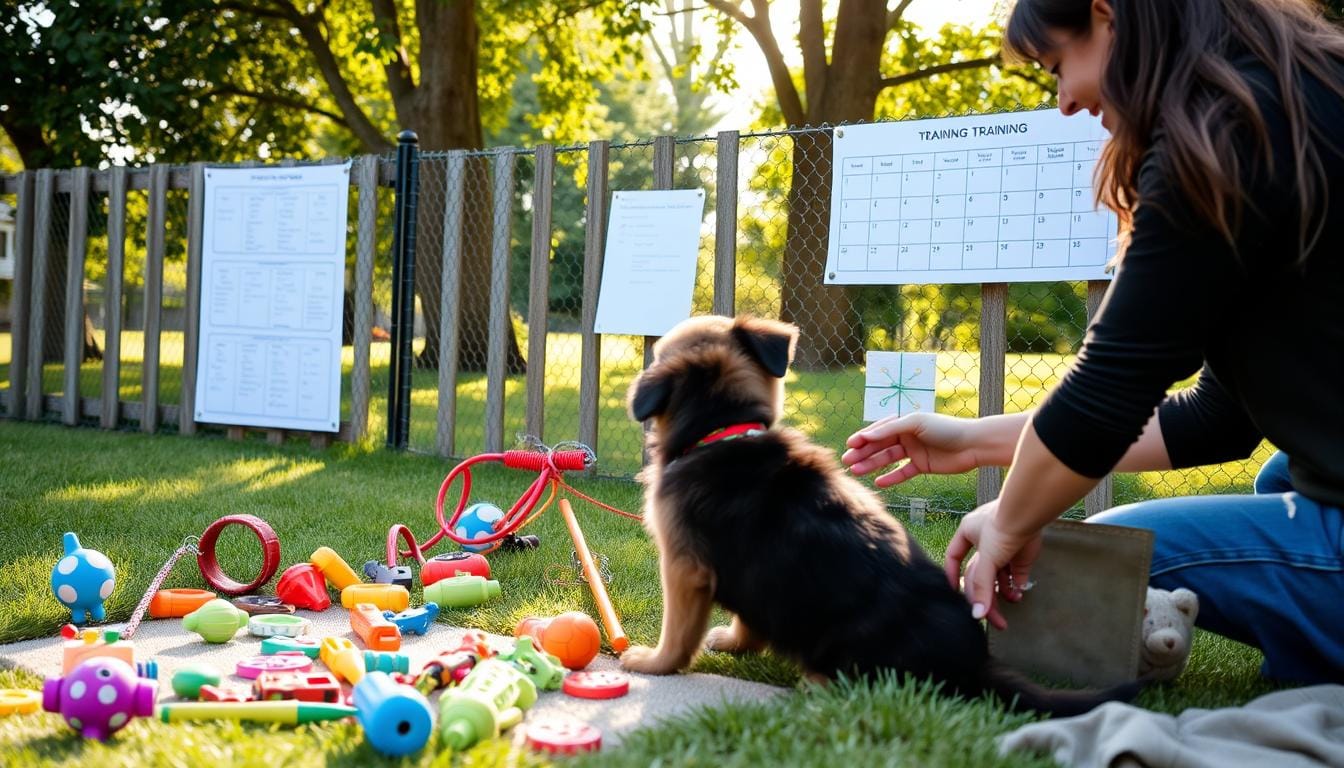
Consistency is crucial in dog training. A regular training schedule keeps you focused and ensures your puppy gets the training they need. Studies show that clear cues from all family members reduce confusion for dogs23. This is vital for positive reinforcement training, which builds trust and strengthens your bond with your puppy.
Start with a daily routine of 10-15 minutes for basic commands like sit, stay, and come. Tracking your puppy’s progress helps you adjust your training plan. High-value rewards like treats and praise motivate your puppy and reinforce good behavior24. The goal is to build a strong bond with your puppy through effective training.
Here are some tips for a consistent training schedule:
- Set aside a specific time each day for training
- Use positive reinforcement techniques, such as treats and praise
- Track your puppy’s progress and adjust your training schedule as needed
- Be consistent in your behavior cues and rewards
By following these tips and using effective training methods, you can establish a consistent schedule for you and your puppy.
With patience, consistency, and positive reinforcement, your puppy can become a well-behaved adult dog. Stay flexible and adjust your training as your puppy grows and matures25.
| Training Technique | Description |
|---|---|
| Positive Reinforcement | A training method that uses rewards to encourage good behavior |
| Clicker Training | A training method that uses a clicker to mark good behavior |
Understanding Your Puppy’s Body Language
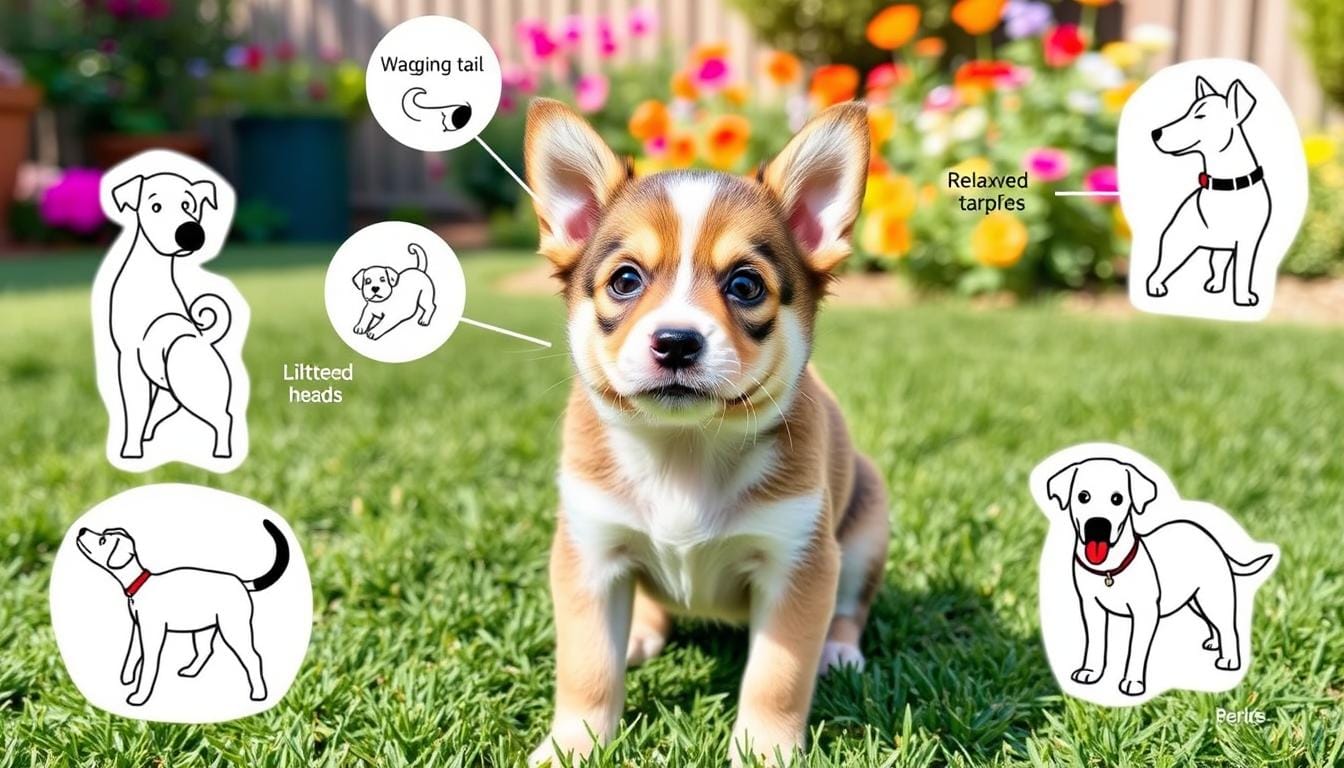
When you’re teaching your puppy to obey, remember that communication with your puppy is more than just words. It’s key to know their body language to solve puppy behavior problems and grow closer to them26. Watch their tail, how they stand, and their face to grasp their feelings and needs.
Dogs show their feelings through body language, like stress, fear, and joy27. A tucked tail or low body can mean they’re scared or worried. But a play bow or wagging tail shows they’re excited or ready to play. Knowing these signs helps you react right and avoid puppy behavior problems.
To really communicate with your puppy, watch their body language and act on it. Notice signs of stress, like yawning or lip-licking, and use positive actions and calm to help them28. This builds trust and a strong bond, making obedience training for puppies more effective.
Some important body language signs to watch for include:
- Tail position and movement
- Ear angle and posture
- Eye movement and focus
- Mouth shape and tension
By understanding these signs and reacting right, your puppy will feel safer and communicate better with you26.
The Role of Exercise in Improving Obedience

Exercise is key to better obedience in dogs. It cuts down on bad behaviors and boosts their health29. Dogs need regular workouts to stay healthy and avoid problems like obesity and joint issues30.
Mental games are also vital. They help dogs think better and learn commands faster30.
When training your dog, mix physical and mental exercises. Try agility, obedience, and puzzle toys. Use positive training methods to help your dog focus and obey better30.
Here are some important tips for exercising your dog:
- How much exercise a puppy needs depends on its age and breed29
- Mental games can tire puppies just as much as physical ones29
- It’s important to balance play and training to avoid too much excitement30
Adding exercise to your training routine can make your dog more obedient. Always use positive training methods. This strengthens your bond and improves obedience29.
Unlock Your Puppy’s Full Potential with Proven Training Techniques
Is your puppy not listening to commands, leaving you frustrated? You’re not alone—but there’s a simple, proven solution!
With Adrienne Farricelli’s Brain Training for Dogs, tap into your puppy’s hidden intelligence to overcome disobedience, eliminate bad habits, and nurture a loving, well-behaved companion.
Why Choose This Program?
✅ Address why puppies don’t listen at the root.
✅ Build a stronger bond using fun, science-backed methods.
✅ Access expert guidance and step-by-step videos at your convenience.
Take Action Now!
Start seeing results today with this risk-free program, backed by a 60-day guarantee.
👉 Click Here to Get Started with Brain Training for Dogs!
Don’t wait—transform your puppy’s behavior and enjoy a stronger, more obedient relationship!”
Conclusion: Building a Lifelong Bond Through Patient Training
Starting your puppy training journey means patience, consistency, and positive reinforcement31. Dogs grow loyal to their owners, showing that your bond can last forever31. Training regularly and rewarding them is key for obedience31. Positive reinforcement helps you communicate better and build trust with your pet.
Daily playdates and activities, like dog parks or hikes, are great for your puppy’s health31. They also strengthen your bond31. It’s important to understand your puppy’s body language to avoid misunderstandings31.
Professional trainers stress the importance of lifelong training for dog owners32. Regular training and socialization can cut down behavioral problems by over 50%32. With patience and effort, you can create a strong, lasting bond with your puppy. This will bring joy to both of you for many years.
FAQ
Why do puppies sometimes seem to ignore commands or training?
Puppies might ignore commands for many reasons. This includes not knowing the right training methods, being distracted, or just being young. Knowing how puppies learn and using positive training helps them listen better.
How does a puppy’s cognitive development and natural instincts impact their ability to learn?
Puppy brains and instincts greatly affect their learning. Understanding this helps you tailor your training. This makes training more effective for your puppy.
What is the importance of early development in puppy obedience training?
Early training is key for good habits and a strong bond. Using positive training and patience early on sets your puppy up for success.
Are there common misconceptions about puppy training that I should be aware of?
Yes, many myths about puppy training can slow your progress. Knowing the truth about their attention span, breed traits, and the power of positive training helps you train better.
How can I improve communication and build a strong foundation with my puppy?
Good communication is vital for puppy training. Focus on positive reinforcement, be consistent, and understand their body language. This builds a strong bond and improves obedience.
What role does the environment play in puppy learning, and how can I optimize it?
The environment greatly affects a puppy’s learning. Reduce distractions, create a good learning space, and understand how the environment influences their behavior. This sets your puppy up for success.
What are some essential training techniques for improving a puppy’s listening skills?
Using positive reinforcement, like rewards and praise, is very effective. Being consistent in your training also helps teach your puppy to listen better.
How can I effectively use positive reinforcement in my puppy’s training?
Positive reinforcement is a powerful tool. Choose the right rewards, time your praise and rewards well, and build positive associations. This reinforces good behavior and improves obedience.
How can I address common behavioral challenges with my puppy?
Many issues, like jumping or disobedience, can be solved with positive training. Understand the cause and tailor your training to overcome these challenges.
How do I create a consistent training schedule for my puppy?
Creating a consistent schedule is crucial. Include daily routines, track progress, and adjust as your puppy grows. This approach reinforces good behavior and keeps your puppy learning.
What should I know about understanding my puppy’s body language?
Knowing your puppy’s body language is important. It shows their mental state and helps you make better training decisions. This way, you can communicate better and address any issues.
How can exercise help improve my puppy’s obedience?
Exercise and mental stimulation are key. The right amount of play and training keeps your puppy engaged and motivated. This improves obedience.
Source Links
- https://www.petprofessionalguild.com/pet-owners/pets-and-their-people/pets-and-their-people-blog/puppy-not-listening-to-you-heres-why-and-what-to-do/ – Puppy Not Listening to You? Here’s Why and What to Do! – Pet Professional Guild
- https://www.upstatecanine.com/blog/possible-reasons-your-dog-wont-listen-to-basic-commands/ – Possible Reasons Your Dog Won’t Listen to Basic Commands – Upstate Canine Academy
- https://www.fenzidogsportsacademy.com/blog/it-s-a-puppy-not-a-problem – It's a Puppy, Not a Problem
- https://dogswithlia.com/dog-psychology-x-dog-training-part-3/ – Understanding Dog Psychology for Effective Training – A Dog’s Life with Lia
- https://projectupland.com/hunting-dogs/eye-contact-during-dog-training/ – The Importance of Eye Contact During Dog Training
- https://www.summitdogtraining.com/blog/surviving-puppy-adolescence – Surviving Puppy Adolescence With Your Sanity (and Love for Your Puppy) Intact
- https://fenrircanineleaders.com/blogs/articles/early-puppy-development-from-breeder-insights-to-temperament-testing?srsltid=AfmBOoq_bNxPWSoSEwHu1BFe3dSJCzQJ5t5_VzIJ_ElzAYGYTZtn-XfA – Early Puppy Development: From Breeder Insights to Temperament Testing
- https://www.dogrelationsnewyorkcity.com/dog-training-tips/penny-wise-and-pound-foolish-puppy-training-myths/ – Penny Wise and Pound Foolish: Puppy Training Myths | Dog Relations New York City
- https://pupgradek9.com/why-doesnt-my-dog-listen-to-me/ – Why doesn’t my dog listen to me? – Pupgrade Dog Training
- https://www.gundogmag.com/editorial/learn-to-trust-your-dog/456366 – Learn to Trust Your Dog – Gun Dog
- https://demarinisdogtraining.com/dog-training-tips-for-success/ – Dog Training Tips For Success | How to successfully train my dog
- https://www.oneminddogs.com/blog/my-puppy-doesnt-listen-to-me-what-can-i-do/ – My Puppy Doesn’t Listen To Me — What Can I Do? – OneMind Dogs
- https://www.akc.org/expert-advice/training/training-dogs-to-ignore-distractions/ – No title found
- https://vcahospitals.com/know-your-pet/puppy-behavior-and-training—dealing-with-undesirable-behavior – Puppy Behavior and Training – Dealing with Undesirable Behavior | VCA | VCA Animal Hospitals
- https://pmc.ncbi.nlm.nih.gov/articles/PMC6067676/ – Puppy parties and beyond: the role of early age socialization practices on adult dog behavior
- https://www.drjensdogblog.com/show-me-the-money-why-your-dog-doesnt-listen-unless-youre-holding-food/ – Show Me The Money: Why Your Dog Doesn’t Listen, Unless You’re Holding Food
- https://smartdoguniversity.com/what-to-do-if-your-dog-doesnt-listen-in-public/ – What to Do If Your Dog Doesn’t Listen in Public – Smart Dog University
- https://www.dogforum.com/threads/a-few-thoughts-on-positive-reinforcement-only-training.378228/ – A few thoughts on positive reinforcement only training
- https://leerburg.com/allpositive.htm?srsltid=AfmBOop-p4chdP1YbtR7ugbZHPsOifEFb-433piDV8C02YlvkzOvRCQ9 – The Problem with All-Positive Dog Training
- https://www.nylabone.com/dog101/tips-for-solving-common-behavior-problems – 13 Dog Behavioral Issues & Tips to Solve Them | Nylabone
- https://www.caninecampus.us/6-reasons-your-dog-doesnt-listen-understanding-canine-behavior – 6 Reasons Your Dog Doesn’t Listen: Understanding Canine Behavior – Canine Campus Dog Daycare & Boarding
- https://missbehaviortraining.com/blog/notlistening – Why Your Dog Doesn’t Listen To You
- https://www.vetstreet.com/pet-care/training/7-strategies-for-training-a-stubborn-dog – 7 Tips for Training a Stubborn Dog – Vetstreet
- https://zigzag.dog/en-us/blog/puppy-training/training-basics/how-to-get-your-dog-to-focus-on-you-outside/ – How To Get Your Dog To Focus On You Outside – Zigzag
- https://www.dogster.com/dog-training/how-to-train-a-stubborn-dog – How to Train a Stubborn Dog Who Won’t Listen: 10 Vet-Approved Tips – Dogster
- https://blog.smartanimaltraining.com/2016/09/08/understanding-dog-body-language/ – Understanding Dog Body Language – Smart Animal Training Systems…
- https://www.akc.org/expert-advice/advice/how-to-read-dog-body-language/ – No title found
- https://www.dummies.com/article/home-auto-hobbies/pets/dogs/general-dogs/understanding-your-puppys-body-language-176221/ – Understanding Your Puppy’s Body Language
- https://www.akc.org/expert-advice/training/puppy-active-stimulation-and-exercise/ – No title found
- https://fotp.com/learn/dog-health/physical-vs-mental-exercise-for-dogs—whats-the-difference – Physical vs Mental Exercise for Dogs – What’s The Difference? | FOTP
- https://www.fitbark.com/blog/building-a-bond-with-a-pet-dog-will-last-you-a-lifetime – Building A Bond With A Pet Dog Will Last You A Lifetime | FitBark
- https://vocal.media/petlife/the-lifelong-journey-of-dog-training-why-it-s-never-truly-over – The Lifelong Journey of Dog Training: Why It’s Never Truly Over
